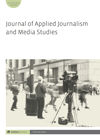
Full text loading...

 , Michalis Tastsoglou1
, Michalis Tastsoglou1
During the 2020 lockdown, news outlets played an important role on the public perceptions on public health crisis. Through framing, news outlets shape a given reality, present possible interpretations, exclude certain persons and organizations while providing visibility to others. In that sense, media influence public perceptions of expertise. In the case of COVID-19, experts’ views were crucial in raising public awareness as well as promoting appropriate and effective ways with addressing the crisis. Present research considers as an expert any person or organization who was deemed capable by news outlets to consult the audience on how to protect themselves from COVID-19. This study focuses on major news outlets in the Greek media system and their framing of expertise from 1 February 2020 to 30 April 2020. This period begins with the emergence of COVID-19 as the dominant issue in news stories. The sample consists of 2389 news items from six websites and six television (TV) stations. The research aims to understand whether news outlets frame (or not) certain organizations and persons as experts. By employing quantitative content analysis, general tendencies in framing are analysed. The results infer that public officials were framed as the main category of experts. Greek news outlets in most cases avoided framing World Health Organization (WHO) representatives as experts, especially after the first death by COVID-19 in Greece (12 March 2020). In general, the reference period was proven to be a crucial factor as expertise frames were differentiated before and after the first death in Greece and the implementation of lockdown measures. Moreover, research also confirmed that during health crises journalists prefer the thematic frame.

Article metrics loading...

Full text loading...
References


Data & Media loading...
Publication Date:
https://doi.org/10.1386/ajms_00120_1 Published content will be available immediately after check-out or when it is released in case of a pre-order. Please make sure to be logged in to see all available purchase options.